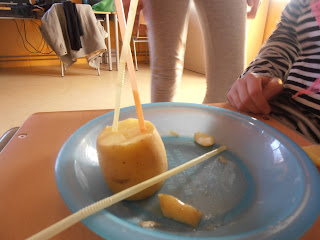- A deep dish
- Full-cream milk
- Dishwasher soap
- Food colouring
- Cotton swabs
HOW TO DO IT:
1. Put some full-cream milk in a deep dish.
2. Add food colouring in the centre of it.
3. Dip a cotton swab in the
dishwasher soap.
4. Put the cotton swab in the centre of the food
colouring.
PREDICTIONS:
PROCESS:
RESULTS:
Full-cream milk, as the name says, contains all the fat or grease that normal milk has. As you know, dishwasher soap is degreaser, which means that takes out the grease. Food colouring helps us see the movement of the milk, and it moves because it has grease and we are adding a degreaser, it is like the milk is "afraid" of the soap.
MILK (FAT OR GREASE)
+
DISHWASHER SOAP (DEGREASER - TAKES OUT THE FAT OR GREASE)
=
THE MILK GOES AWAY FROM THE SOAP
OUR OPINION:

















